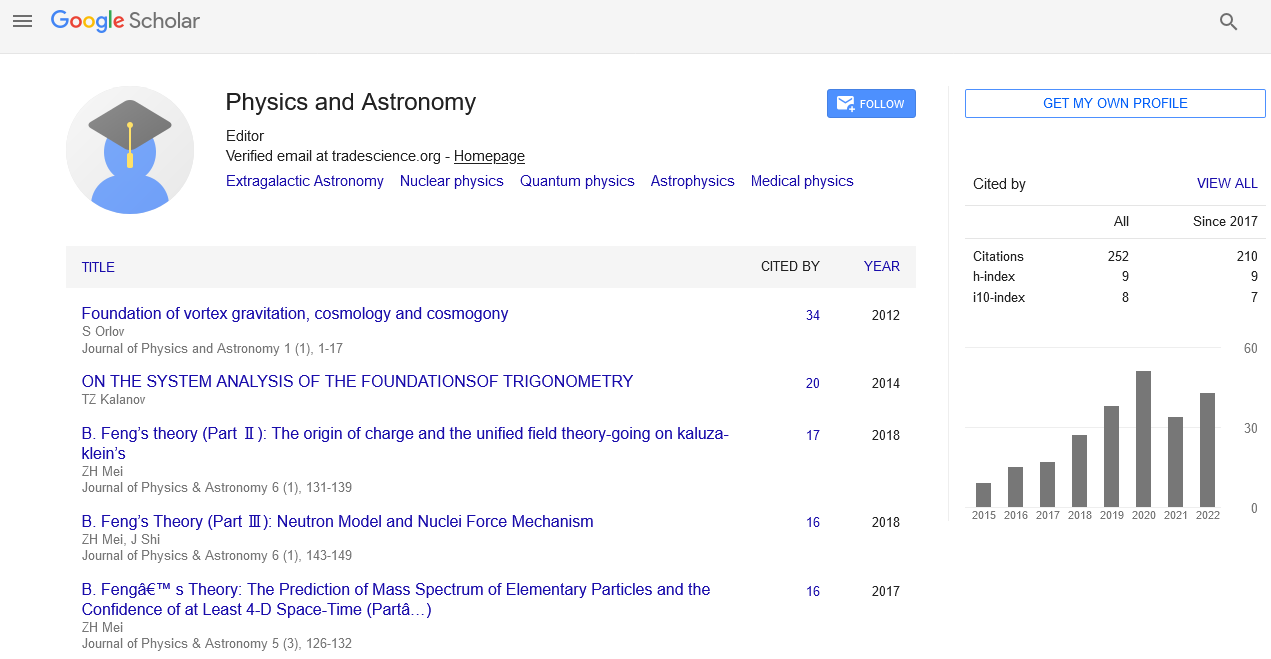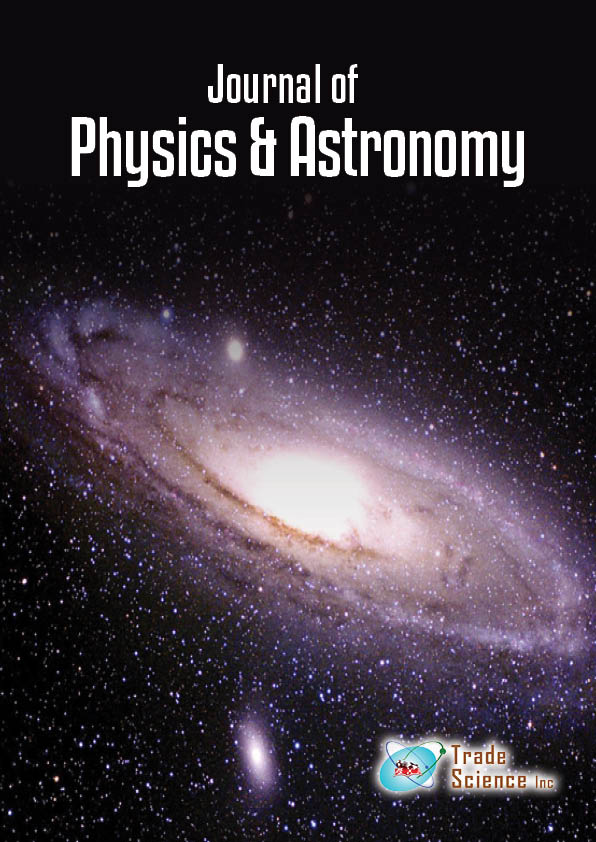Research
, Volume: 12( 11)Holographic Address Space: A Framework for Unifying Quantum Mechanics and General Relativity
- *Correspondence:
- Bhushan Poojary
Department of Physics, NIIMS University, Jaipur, India
E-mail: bhushanpoojary@gmail.com
Received date: Nov-11-2024, Manuscript No. tspa-24-154863; Editor assigned: Nov-16-2024, Pre-QC No. tspa-24-154863(PQ); Reviewed: Nov-19-2024, QC No. tspa-24-154863(Q); Revised: Nov-24-2024, Manuscript No. tspa-24-154863(R); Published: Nov-30-2024, DOI.10.37532/2320-6756.2024.12(11).346
Citation: Poojary B. Holographic Address Space: A Framework for Unifying Quantum Mechanics and General Relativity. J Phys Astron. 2024;12(11):346.
Abstract
This paper introduces a novel framework for unifying quantum mechanics and general relativity through the concept of a holographic address space. It proposes that particles and fields are defined by their dynamics in this address space, with horizontal motion representing quantum evolution and vertical motion representing wave function collapse. By treating the address space as a dynamic entity, the framework establishes connections between quantum phenomena, gravity, and cosmological observations. The paper includes initial mathematical formulations and testable predictions to bridge theory and experiment.
Keywords
Space; Quantum mechanics; Holographic planes; Relativistic principles
Introduction
The unification of quantum mechanics and general relativity remains one of the greatest challenges in physics. Traditional approaches, such as string theory and loop quantum gravity, often struggle to reconcile the probabilistic nature of quantum mechanics with the deterministic structure of spacetime [1,2]. This paper explores an alternative: a holographic address space where all particles and fields are represented as addresses in a multidimensional plane.
In this framework, the horizontal motion of addresses corresponds to quantum evolution, governed by the Schrödinger equation, while vertical motion corresponds to wave function collapse. The address space itself is influenced by curvature, density, and external interactions, providing a unified description of both quantum and gravitational phenomena [3,4].
Theoretical Foundations
Holographic address space
The address space is conceptualized as a two-dimensional dynamic plane embedded in a higher-dimensional framework. The horizontal axis describes quantum superposition and evolution, while the vertical axis represents discrete transitions associated with wave function collapse [3].
Horizontal motion (x-axis): Represents the deterministic evolution of a quantum system.
Governed by  the Hamiltonian operator in the address space.
the Hamiltonian operator in the address space.
Vertical Motion (y-axis): Represents the stochastic process of measurement or observation-induced collapse.
Modelled using a discrete operator  that transitions states vertically.
that transitions states vertically.
Mathematically, the total evolution of an address can be expressed as:

where ΨH represents the horizontal wave function evolution, and ΨV represents vertical transitions [3,5].
Wave function collapse as vertical motion
In this framework, wave function collapse is reinterpreted as a vertical motion in the address space. During a measurement, the address transitions vertically, localizing in the holographic plane. The degree of collapse depends on the interaction strength between the quantum system and the measuring apparatus [6].
Connection to General Relativity
Curvature in address space
The address space interacts with spacetime curvature, linking the density of addresses to gravitational effects. The Einstein field equations may be reinterpreted as governing the curvature of the address plane:

where ρa is the address density, which acts as a source term in spacetime curvature [1,7].
Address fields
Fields are represented as variations in the address density or curvature in the holographic plane. For example, electromagnetic fields can be modelled as oscillations in horizontal motion, while gravitational waves correspond to ripples in address density [5,8].
Applications and Predictions
Quantum gravity
This framework provides a novel perspective on quantum gravity by treating spacetime as emergent from address dynamics. The interplay between horizontal and vertical motions could offer insights into black hole entropy and holographic principles [7].
Dark matter and dark energy
The address density in regions of low interaction may manifest as dark matter, while variations in address field curvature could account for dark energy. For example, the gravitational lensing effects attributed to dark matter might be explained through address density gradients [6].
Big Bang and Cosmology
The Big Bang can be interpreted as the simultaneous emergence of horizontal and vertical motions, marking the beginning of address dynamics. The inflationary phase corresponds to rapid horizontal expansion, while vertical transitions seeded early structure formation [7].
Experimental Validation
Gravitational effects on wave function collapse
Experiments could investigate whether wave function collapse is influenced by gravitational fields. For instance:
• Does the collapse rate change near massive objects?
• Are entangled particles influenced differently in varying gravitational potentials [8, 9]?
Delayed-choice quantum experiments
The framework predicts that vertical transitions (wave function collapse) may have holographic signatures. Delayed-choice experiments could test whether the presence of an address field modifies interference patterns [9].
Address density and decoherence
By examining decoherence in systems of varying scales, researchers could explore correlations between address density and quantum-to-classical transitions [6,9].
Mathematical Framework
To develop the framework further, we propose the following equations:
Horizontal motion:

Vertical motion (collapse dynamics):

Where Δy is the discrete vertical shift in the address plane.
Curvature effects:

Linking address density to the stress-energy tensor [7].
Extensions and Future Work
The framework opens avenues for exploring quantum gravity, holographic information, and cosmology. Future work will focus on:
• Refining mathematical formulations and integrating them with established theories.
• Proposing concrete experimental setups for falsification.
• Investigating connections to black hole entropy and the AdS/CFT correspondence.
Conclusion
This paper presents a novel framework for unifying quantum mechanics and general relativity through the concept of a holographic address space. By treating wave function collapse as vertical motion and quantum evolution as horizontal motion, the framework offers a dynamic view of reality that bridges micro and macro-scales. While speculative, it provides a promising foundation for further theoretical and experimental exploration.
References
- Wheeler JA. Information, physics, quantum: The search for links. Feynman Comput. 2018. 309-36.
- Sachs M. On Hawking's A Brief History of Time and the present state of physics. Br J Philos Sci. 1993;44(3):543-7.
- Dirac PA. The principles of quantum mechanics. Oxf Univ Press. 1981.
- Heisenberg W. The physical principles of the quantum theory. Cour Corp. 2013.
- Maldacena J. The large-N limit of superconformal field theories and supergravity. Int J Theor Phys. 1999; 38(4):1113-33.
- Tegmark M. The interpretation of quantum mechanics: Many worlds or many words? Fortschr Phys: Prog Phys. 1998;46(6?8):855-62.
- Bekenstein JD. Black holes and entropy. Phys Rev D. 1973;7(8):2333.
- Penrose R. The Road to Reality: A Complete Guide to the Laws of the Universe.
- Aspect A, Grangier P, Roger G. Experimental tests of realistic local theories via Bell's theorem. Phys Rev Lett. 1981;47(7):460.

